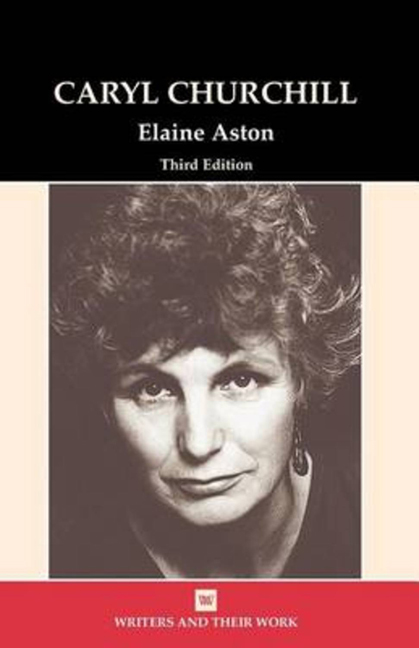Book contents
- Frontmatter
- Dedication
- Contents
- Acknowledgements
- Biographical Outline
- Abbreviations
- Preface
- Prologue
- 1 Beginnings: Radio, Stage and Television
- 2 The ‘Woman Writer’
- 3 The Dramatist as Socialist Critic
- 4 Communities in Dramatic Dialogue
- 5 Exploding Words and Worlds
- 6 1997 - Far Away
- 7 A Royal Court Celebration
- Notes
- Select Bibliography
- Index
Prologue
- Frontmatter
- Dedication
- Contents
- Acknowledgements
- Biographical Outline
- Abbreviations
- Preface
- Prologue
- 1 Beginnings: Radio, Stage and Television
- 2 The ‘Woman Writer’
- 3 The Dramatist as Socialist Critic
- 4 Communities in Dramatic Dialogue
- 5 Exploding Words and Worlds
- 6 1997 - Far Away
- 7 A Royal Court Celebration
- Notes
- Select Bibliography
- Index
Summary
Caryl Churchill is widely acknowledged as a major contemporary British dramatist and leading figure on the international stage. While her theatre continues to receive popular critical attention and public acclaim, the woman behind the drama remains an intensely private person. In interviews (which she prefers not to give) Churchill, the writer, makes it clear that it is through her work that she wishes to be known.
This short study, therefore, gives an account of the writer through her work for the theatre and related media. Adopting a critically informed, introductory approach to key published and/or performed works, accessible to readers and spectators, the study begins with an overview of Churchill's early writing for radio, television and theatre, which has received less critical attention than some of her later stage plays. As testimony to the importance of Churchill's theatre in the context of contemporary women's drama and feminist theatre scholarship, Chapter 2 is devoted to an account of the emergent ‘woman writer’. Chapter 3 examines the broader, socialist canvas of her playwriting, and the political perspective of her work also informs Chapter 4 which analyses the methodology and ideology of researching and dramatizing oppressed communities. Chapter 5 looks at Churchill's ‘shapeshifting’, innovative theatre-making which makes her plays radically resistant to classification or categorization, and Chapter 6 traces the most recent developments in her theatre, through to her first play of the twenty-first century - Far Away.
What emerges is a Churchillian landscape which is characteristically ‘frightening’, greedy, corrupt, violent and damaged, and is populated with oppressed groups - particularly of women - marked by powerlessness, division and dispossession. In making visible the hidden realities of an unequal world, however, Churchill invites her spectators to share in the Utopian possibility of an ‘upside down world’ - a veritable ‘Cloud Nine’. Or, to face the consequences of a distopian world ‘out of joint’.
- Type
- Chapter
- Information
- Caryl Churchill , pp. 1 - 2Publisher: Liverpool University PressPrint publication year: 2010

